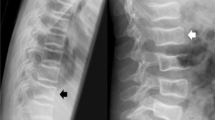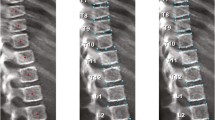Abstract
The identification of vertebral fracture in osteoporosis is based mainly on the identification of abnormal variation in vertebral shape, but this can be misleading in the presence of a non-fracture deformity or normal variant of vertebral shape. Qualitative identification of vertebral fracture (Qual) is influenced by the subjectivity of the approach, and although more objective, the semiquantitative method (SQ) can be difficult to apply. In addition, there has been little independent evaluation of SQ in relation to other approaches. We aimed to evaluate a new algorithm-based approach for the qualitative identification of vertebral fracture (ABQ) and to compare it with SQ and Qual. Two radiologists reported spinal radiographs for 372 postmenopausal women using Qual (reader 1), and SQ and ABQ (reader 2). Non-fracture deformities and normal variants were also reported using Qual and ABQ. The prevalence of vertebral fracture by subjects was higher for SQ (24%) than for Qual (11%) and ABQ (7%). Agreement was poor between SQ and the other methods, and moderate between Qual and ABQ. Twenty-two women with vertebral fracture were agreed by all three methods, similar to the total identified by ABQ (25 women). Seventeen women diagnosed with fracture by Qual, had non-fracture deformity or normal variant (but no fracture) according to ABQ. Of the women with SQ fractures, 53% and 70% were identified negative for fracture but positive for non-fracture deformity or normal variant by ABQ and Qual. The main sources of discrepancy between SQ and the other methods were Scheuermann’s disease, normal variation, and degenerative change accompanied by short anterior vertebral height. For all methods, bone mineral density (BMD) and BMD Z-scores were lower in women with vertebral fractures than in those with no fractures. Bone mineral density and BMD Z-scores were also lower at the lumbar spine and total body in women with vertebral fractures according to Qual and ABQ than they were for SQ, and were lower in women with SQ fractures agreed by Qual and ABQ, compared with those diagnosed negative for fracture by Qual and ABQ (p<0.01). We conclude that poor agreement between methods arises mainly from difficulties in differentiating true fracture from non-fracture deformity. Our new approach attempts to address this problem but requires further testing in a larger study population.





Similar content being viewed by others
References
Hedlund LR, Gallagher JC (1988) Vertebral morphometry in diagnosis of spinal fractures. Bone Miner 5:59–67
Minne HW, Leidig G, Wuster C, Siromachkostov L, Baldauf G, Sauer P, Lojen M, Ziegler R (1988) A newly developed spine deformity index (SDI) to quantitate vertebral crush fractures in patients with osteoporosis. Bone Miner 3:335–349
Smith-Bindman R, Steiger S, Cummings SR, Genant HK (1991) The index of radiographic area (IRA): a new approach to estimating the severity of vertebral deformity. Bone Miner 15:137–150
Black DM, Cummings SR, Stone K, Huden K, Palermo L, Steiger P (1991) A new approach to defining vertebral dimensions. JBMR 8:883–891
Eastell R, Cedel SL, Wahner HW, Riggs BL, Melton LJ III (1991) Classification of vertebral fractures. J Bone Miner Res 6:207–215
Davies KM, Recker RR, Heaney RP (1993) Revisable criteria for vertebral deformity. Osteoporos Int 3:265–270
McCloskey EV, Spector TD, Eyres KS, Fern ED, O’Rourke N, Vasikaran S, Kanis JA (1993) The assessment of vertebral deformity: a method for use in population studies and clinical trials. Osteoporos Int 3:138–147
Melton LJ, Lane AW, Cooper C, Eastell R, O’Fallon WM, Riggs BL (1993) Prevalence and incidence of vertebral deformities. Osteoporos Int 3:113–119
Ross PD, Yhee YK, He Y-F, Davis JW, Kamimoto C, Epstein RS, Wasnich RD (1993) A new method for vertebral fracture diagnosis. JBMR 2:167–174
Genant K, Wu CY, Kuijk CV, Nevitt MC (1993) Vertebral fracture assessment using a semi-quantitative technique. J Bone Miner Res 8:1137–1148
Hurxthal LM, Vose GP, Detter WE (1969) Densitometric and visual observations of spinal radiographs. Geriatrics 24:93–106
Jensen FG, McNair P, Boesen J et al (1984) Validity in diagnosing osteoporosis. Eur J Radiol 4:1–3
O’Neill TW, Felsenberg D, Varlow J, Cooper C, Kanis JA, Silman AJ (1996) The prevalence of vertebral deformity in European men and women: the European Vertebral Osteoporosis Study. J Bone Miner Res 11:1010–8
Peel NFA, Barrington NA, Blumsohn A, Colwell A, Hannon R, Eastell R (1995) Bone mineral density and bone turnover in spinal osteoarthrosis. Ann Rheum Dis 54:867–871
Eastell R, Cedel SL, Wahner,HW, Riggs BL, Melton LJ III (1991) Classification of vertebral fractures. J Bone Miner Res 6:207–215
McCloskey EV, Spector TD, Eyres KS, FernED, O’Rourke N, Vasikaran S, Kanis JA (1993) The assessment of vertebral deformity: a method for use in population studies and clinical trials. Osteoporos Int 3:138–147
Grados F, Roux C, de Vernejoul MC, Utard G, Sebert JL, Fardellone P (2001) Comparison of four morphometric definitions and a semiquantitative consensus reading for assessing prevalent vertebral fractures. Osteoporos Int 12:716–722
Szulc P, Munoz F, Sornay-Rendu E, Paris E, Souhami E, Zanchetta J, Bagur A, Van der Mooren MJ, Young S, Delmas PD (2000) Comparison of morphometric assessment of prevalent vertebral deformities in women using different reference data. Bone 27:841–846
Pak CYC, Ho A, Poindexter J, Peterson R, Sakhaee K (1996) Quantitation of incident spinal fractures: comparison of visual detection with quantitative morphometry. Bone 18:349–353
Genant HK, Jergas M, Palermo L, Nevitt M, Valentin RS, Black D and Cummings SR (1996) Comparison of semiquantitative visual and quantitative morphometric assessment of prevalent and incident vertebral fractures in osteoporosis. J Bone Miner Res 11:984–996
Black DM, Palermo L, Nevitt MC, Genant HK, Epstein R, San Valentin R, Cummings SR (1995) Comparison of methods for defining prevalent vertebral deformities: the Study of Osteoporotic Fractures. J Bone Miner Res 16:890–902
Wu CY, Li J, Jergas M, Genant HK (1995) Comparison of semiquantitative techniques for the assessment of prevalent and incident vertebral fractures. Osteoporos Int 5:354–370
Leidig-Bruckner G, Limberg B, Felsenberg D, Bruckner T, Holder S, Kather A, Mikasch J, Wuster C, Ziegler R, Scheidt-Nave C (2000) Sex difference in the validity of vertebral deformities as an index of prevalent vertebral osteoporotic fractures: a population survey of older men and women. Osteoporos Int 11:102–119
Spector TD, McCloskey EV, Doyle DV, Kanis JA (1993) Prevalence of vertebral fracture in women and the relationship with bone density and symptoms: the Chingford Study. Osteoporos Int 8:817–822
Kleerekoper M (1992) Vertebral fracture or vertebral deformity? Calcif Tissue Int 50:5–6
Abdul-Hamid Osman A, Bassiouni H, Koutri R, Nus J, Geusens P, Dequeker J (1994) Aging of the thoracic spine: distinction between wedging in osteoarthritis and fracture in osteoporosis—a cross sectional and longitudinal study. Bone 15:437–442
Jones G, White C, Nguyen T, Sambrook PN, Kelly PJ, Eisman JA (1996) Prevalent vertebral deformities: relationship to bone mineral density and spinal osteophytosis in elderly men and women. Osteoporos Int 6:233–239
Lyritis GP, Mayasis B, Tsakalakos N, Lambropoulos A, Gazi S, Karachalios T, Tsekoura M, Yiatzides A (1989) The natural history of the osteoporotic vertebral fracture. Clin Rheumatol 8[Suppl 2]:66–69
Acknowledgements
This study was supported by a program grant from the Arthritis Research Campaign. Dr Diana Greenfield was responsible for recruiting subjects, and we thank the staff of the Osteoporosis Centre, Northern General Hospital, Sheffield, UK, in particular the radiographers, for acquisition of BMD scans. Thanks also to Dr Nicola Peel and Dr Jackie Clowes for their assistance in the development of ABQ.
Author information
Authors and Affiliations
Corresponding author
Rights and permissions
About this article
Cite this article
Jiang, G., Eastell, R., Barrington, N.A. et al. Comparison of methods for the visual identification of prevalent vertebral fracture in osteoporosis. Osteoporos Int 15, 887–896 (2004). https://doi.org/10.1007/s00198-004-1626-1
Received:
Accepted:
Published:
Issue Date:
DOI: https://doi.org/10.1007/s00198-004-1626-1




